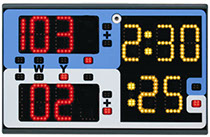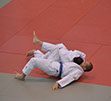City College of San Francisco Judo Club
menu
Scoring of a Judo Match
Objective
In Judo competition the objective is to score an Ippon (one full point). Once such a score is obtained the competition ends. An Ippon can be scored by one of the following methods:
- Executing a skillful throwing technique which results in one contestant being thrown largely on the back with considerable force or speed.
- Maintaining a pin for 20 seconds.
- One contestant cannot continue and gives up.
- One contestant is disqualified for violating the rules (hansoku-make).
- Applying an effective armbar or an effective stranglehold (this does not apply for children).
 If the contest time expires the contestant with the highest score will win. In the event neither contestant scored or the score is tied, the contestants will enter into "Golden Score". The first opponent scoring will win the match.
If the contest time expires the contestant with the highest score will win. In the event neither contestant scored or the score is tied, the contestants will enter into "Golden Score". The first opponent scoring will win the match.
“Ippon”
 When a contestant scores ippon, the referee shall announce, “Ippon” the match is over. The contestant scoring ippon is the winner. An ippon can be scored in both tachi-waza (standing) and ne-waza (groundwork).
When a contestant scores ippon, the referee shall announce, “Ippon” the match is over. The contestant scoring ippon is the winner. An ippon can be scored in both tachi-waza (standing) and ne-waza (groundwork).
Should one contestant be penalized “Hansoku make” (major penalty infraction) the other contestant shall be declared the winner.
Ippon is scored when: A contestant with control throws t he other contestant largely on his back with considerable force and speed.
he other contestant largely on his back with considerable force and speed.
Contestant gives up by tapping twice or more with his hand or foot or says “Maitta” (I give up), shime waza (strangle) or kansetsu-waza (armlock).
“Wazari”
 Waza-ari is scored when: A contestant throws the other contestant with control, but the technique is partially lacking one of the elements necessary for ippon, or a contestant holds with osaekomi-waza the other contestant who is unable to get away for 10 to 19.9 seconds.
Waza-ari is scored when: A contestant throws the other contestant with control, but the technique is partially lacking one of the elements necessary for ippon, or a contestant holds with osaekomi-waza the other contestant who is unable to get away for 10 to 19.9 seconds.
Golden Score
If the score is even at the end of the time allowed for a match, usually there will be a Golden Score period where the timer will be reset and the first contestant to score any point wins.
“Osaekomi”
 The referee shall announce “Osaekomi” when the contestant being held is controlled by the opponent. You must have the opponent back, both shoulders, or one shoulder in contact with the mat. Control can be made from the side, from the rear, or from the top.
The referee shall announce “Osaekomi” when the contestant being held is controlled by the opponent. You must have the opponent back, both shoulders, or one shoulder in contact with the mat. Control can be made from the side, from the rear, or from the top.
“Toketa”
 The contestant applying the hold must not have their leg(s) or body controlled by the opponent’s legs. If the contestant being held down can escape by NOT allowing their back or shoulders be in contact with the mat, the referee would announce “Toketa” the pin is broken and the Osaekomi time stops.
The contestant applying the hold must not have their leg(s) or body controlled by the opponent’s legs. If the contestant being held down can escape by NOT allowing their back or shoulders be in contact with the mat, the referee would announce “Toketa” the pin is broken and the Osaekomi time stops.